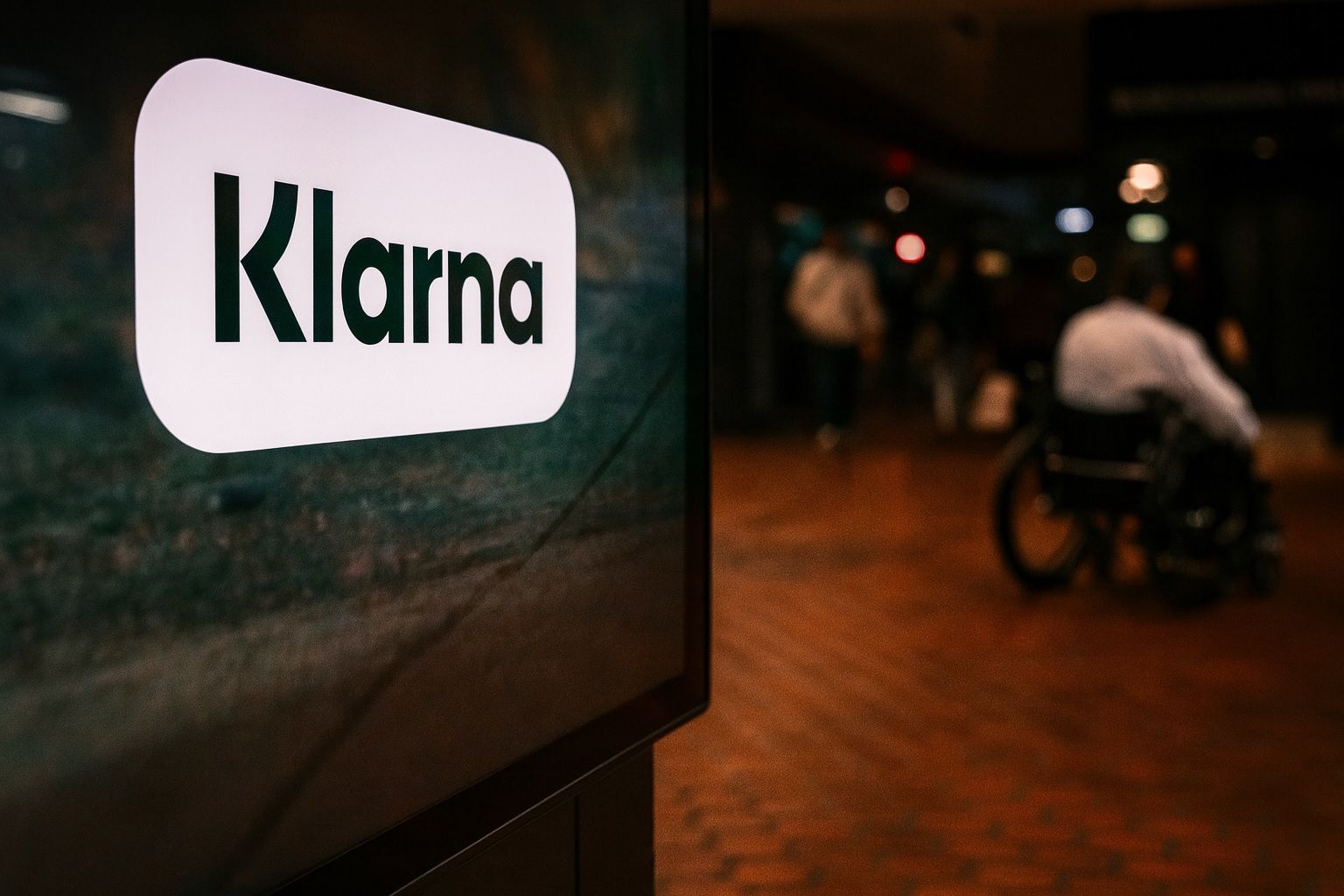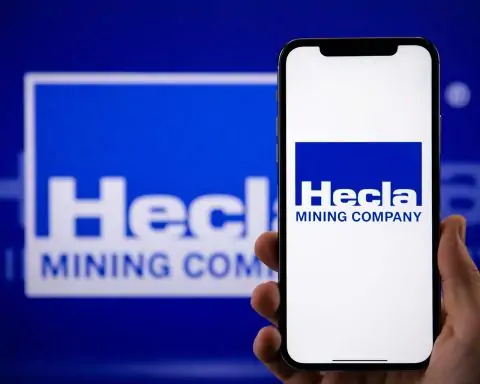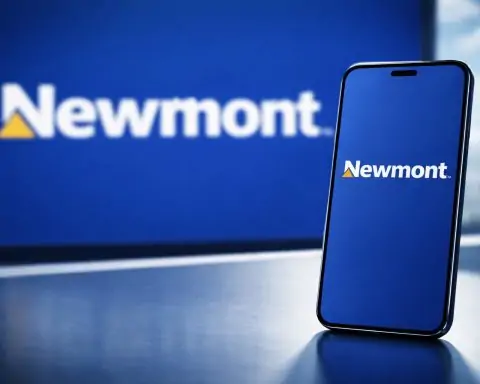- Stock price: KLAR closed mid-Oct 2025 around $35.5, hitting a new 52-week low (~$35.27) [1], well under its $40 IPO price.
- Analyst sentiment: Wall Street remains mostly bullish – consensus is a Moderate Buy (10 Buy, 8 Hold) [2], with average 12-month targets ~$49.6 (implying ~40% upside) [3] [4]. Major brokers (Goldman, DB, Wedbush, BofA) have issued Buy ratings (targets $48–$51) on KLAR [5].
- Key developments: New partnerships are fueling growth expectations. In Oct 2025, Klarna announced an AI-first deal with Google Cloud – pilots show Google’s generative AI is boosting Klarna app engagement (+15%) and orders (+50%) [6]. It also cemented BNPL deals with top retailers: e.g. exclusive installment loans via Walmart’s OnePay app (launching Oct) for terms up to 3 years [7].
- Recent results: Q2’2025 revenue was $823M (+20% YoY) with ~$29M adj. operating income [8]. US GMV grew ~38% YoY, and delinquency (BNPL defaults) stayed very low (~0.89%) [9]. This momentum underpinned Klarna’s $15B+ IPO (Sep 2025, $1.58B raised at $40) [10] [11] (Sequoia’s stake alone jumped ~$2.7B).
- Scale & position: Klarna now bills itself as a “global digital bank” with ~114M active users and ~790K merchant partners [12]. It is the largest BNPL platform (far above Affirm’s ~23M users) [13], powering payments at brands like Nike, Uber, eBay, etc. Its expansion into credit cards, savings, and “phone plans” aims to deepen customer engagement [14].
- Competition & risks: Macroeconomic and regulatory headwinds are notable. Higher interest rates have pressured BNPL valuations [15]. Klarna faces fierce competition from fintechs (Affirm, Afterpay) and tech giants (Stripe’s ~$107B valuation, Revolut ~$75B [16]). Regulators are tightening rules: e.g. Sweden fined Klarna ~$50M in 2024 for compliance lapses [17], and the EU’s incoming AI Act (2026) will impose strict oversight on AI-driven credit tools [18]. These factors add near-term uncertainty.
- Outlook: Analysts’ price targets (in the high $40s to low $50s) imply substantial upside if Klarna executes on growth initiatives [19] [20]. Wedbush calls Klarna’s risk/reward “attractive” given its global network [21], and BofA highlights Klarna’s scale and e-commerce tailwinds [22]. However, investors will watch credit costs and funding prices closely: Citi warns longer-term loans incur higher costs [23]. If Klarna delivers on its “neobank” strategy without major credit hiccups, it could reach analysts’ optimistic targets; any regulatory or macro setback could temper gains [24].
Stock Performance
Since its Sept 2025 NYSE debut, Klarna’s stock has seen a sharp retreat. It opened at $52 on day one [25] but has since slid, closing around $35.5 in mid-October 2025 [26]. That $35 level marks a new one-year low (vs. the $40 IPO price) [27]. The decline mirrors a broader sell-off in high-growth fintech stocks – higher bond yields and stalled Fed rate cuts have dented BNPL valuations [28]. For example, rival Affirm and Afterpay also traded down in recent weeks. Technically, KLAR is well below its 20- and 50-day moving averages. Chart analysts note support ~$36.6 based on recent trading [29]. Key indicators (RSI around 37, MACD turning positive) suggest the pullback may be stabilizing, but a sustained breakout above $45–52 would likely be needed to signal a trend reversal [30].
Strategic Partnerships & News
Klarna has been busy forging strategic partnerships. On Oct. 9, 2025 it announced a major AI partnership with Google Cloud [31]. Under this deal, Klarna will integrate Google’s generative AI stack into its shopping platform, using models like Gemini to create dynamic product “lookbooks” and personalized ads. Early pilots have been promising – Klarna reports AI-powered content has already boosted time spent in-app by ~15% and increased orders by 50% [32]. Google’s VP Marianne Janik says the collaboration will give Klarna “AI-optimized” tools to drive innovation [33].
Separately, Klarna is expanding its merchant network. In September 2025 it won a marquee partnership with Walmart: Klarna will be the exclusive installment-loan provider in Walmart’s OnePay digital wallet [34]. U.S. shoppers, once approved, can then finance Walmart purchases with Klarna for terms ranging 3 to 36 months [35]. The rollout starts in stores and online later this month. Klarna executives stress the strategic goal: “Our aspiration is to be ubiquitous at the checkout,” says CCO David Sykes [36]. By appearing as a regular payment option (e.g. on the Walmart app), Klarna aims to build habitual consumer use — a critical factor in the BNPL business [37].
These recent deals underline Klarna’s growth strategy: leverage technology (AI) and retail tie-ups to attract users and merchants. Other partnerships (with Stripe, eBay, Macy’s, etc.) continue behind the scenes. With holiday shopping season approaching, investors will watch whether these moves start converting to higher transaction volumes.
Financial Results & IPO Context
Klarna’s latest financials show ongoing momentum. In Q2 2025 (released Aug 2025) revenue was $823 million, up 20% year-over-year [38]. The company reported ~$29 million in adjusted operating profit, meaning it is one of the few high-growth fintechs already profitable on a GAAP basis [39]. Gross merchandise volume (GMV) – the total value of transactions – was strong, especially in the U.S. (up ~38% YoY). Active user count hit 111 million (global consumers) and merchant partners numbered ~790,000 [40]. Importantly, credit losses remained modest: BNPL delinquency was around 0.89% [41], reflecting rigorous underwriting.
These fundamentals helped fuel Klarna’s September 2025 IPO. The company sold ~34.3 million shares at $40 each, raising roughly $1.58 billion [42]. The opening valuation exceeded $15 billion [43], making it the biggest U.S. tech listing of the year for a European company. On debut day, KLAR stock popped 15% to $52 [44] before settling down. Veteran backers benefited handsomely: e.g. Sequoia Capital’s 2025 gains on its Klarna stake are estimated around $2.7 billion [45].
Klarna now emphasizes that it is more than a payments firm – it calls itself a “global digital bank and flexible payments provider.” Besides BNPL, it offers a co-branded debit/credit card, interest-bearing savings, and even phone installment plans [46]. Management highlights 114 million active users worldwide and high efficiency (roughly $1M revenue per employee) [47] [48]. The idea is to monetize this network: growing e-commerce and expanding product suite can drive more transaction fees, interchange revenue, and eventually advertising income. Deutsche Bank and JPMorgan, in fact, pointed out Klarna’s ability to tap the large online ad market, given its high-intent shoppers [49]. All of this underpins analysts’ expectation of continued GMV and revenue growth in coming quarters.
Business Model & Competition
Klarna’s core business remains Buy-Now-Pay-Later (BNPL) loans: customers split purchases into installments via the Klarna app. But it is diversifying into a broader “neobank” model. Key pieces include the Klarna Card (launched 2025 in the U.S.), instant payout for merchants, and integrations that let users manage everything in one platform [50]. CEO Sebastian Siemiatkowski describes the pivot as partly a survival strategy in a tougher market, aiming to have multiple revenue streams beyond basic BNPL interest.
In terms of market position, Klarna stands out for scale. It is by far the largest BNPL provider: over 111 million consumers globally and nearly 970,000 merchant partners [51]. By comparison, chief U.S. rival Affirm has only ~23 million users and 377,000 merchants [52]. This wide network allows Klarna to promote cross-selling (e.g. its card or savings) and capture more data.
However, competition is fierce. Other fintech and finance companies are aggressively expanding in payments. For example, Stripe ($107B valuation) and Revolut ($75B) are pouring capital into frictionless payment tools [53]. Traditional banks (via Visa/Mastercard offerings) and tech firms (Apple Pay, Google Pay) also aim to entrench their own installment credit options. In response, Klarna is rapidly adding features (like the resell-on-eBay function introduced in late 2024) to lock in users. Analyst reports note that as Klarna branches into new services, it will need to maintain strong margins. For instance, its “Fair Financing” longer-term loans carry higher funding costs than short-term BNPL, which could weigh on profitability in the short run [54].
Overall, Klarna’s business model is a mix of lending profit and platform fees. It earns interest on customer loans (which is more significant as it moves to multi-month financing) and takes fees on merchant transactions. It has also hinted at ad revenue: Deutsche Bank estimates the online ad space Klarna could address is ~$475 billion [55], suggesting a future growth area. Whether Klarna can leverage its shopping app and data to capture ad dollars remains a longer-term theme for investors.
Analyst Perspectives & Future Outlook
Most analysts are optimistic on Klarna’s medium-term outlook. As of early Oct 2025, heavyweights like Deutsche Bank, Wedbush, and BofA issued initiation reports on KLAR, all with Buy/Outperform ratings [56]. Their 12-month price targets range from the upper $40s to low $50s (DB $48, Wedbush $50, BofA $51) [57]. These assume the stock can regain its first-day highs near ~$52. Wedbush highlighted the attractive “risk/reward” in Klarna’s case, given its dominant franchise and expansion runway [58]. Bank of America similarly cited Klarna’s massive user base and broadening product mix as reasons for confidence [59]. TipRanks shows a Strong Buy consensus on KLAR, with an average target around $53.5 (roughly 30% above current levels) [60].
Looking ahead, analysts see a few key drivers: continued BNPL adoption globally (BNPL is forecast to reach ~$117 billion in volume by 2025 [61]), growth of e-commerce, and cross-selling of new products (cards, savings, etc.). A strong holiday shopping season, for example, could boost GMV and demonstrate execution on these retail partnerships. If Klarna meets its plans (e.g. expanding into new regions and products), most models project it could trade back up towards the high-$40s or beyond by late 2026 [62].
That said, experts also flag risks. Apart from funding costs, credit quality is a watchpoint: Morgan Stanley cautions Klarna must focus on prime borrowers to avoid losses [63]. Rising delinquencies in longer loans could pressure margins. Regulatory changes are another wildcard (see below). For now, however, analysts generally view KLAR as under-penetrated: it still trades below multiples of some U.S. peers (e.g. Affirm) [64], suggesting that sustained growth could lift the valuation.
Regulatory Environment & Risks
Klarna operates in a rapidly evolving regulatory landscape. In the EU and UK, governments are pushing new rules on consumer credit and fintech. Notably, the upcoming EU AI Act (effective 2026) will classify AI-driven credit tools as “high risk,” requiring transparency and human oversight [65]. This could affect Klarna’s AI initiatives (for underwriting or marketing) by imposing compliance costs. Klarna has already been in regulators’ crosshairs: Sweden’s financial watchdog fined the company about $50 million in 2024 for anti-money laundering deficiencies [66]. CEO Siemiatkowski publicly challenged the fine, but it highlights how compliance issues can create volatility and expenses.
Globally, BNPL is under scrutiny as some countries consider treating it more like traditional lending (e.g. requiring credit checks or interest caps). Rising interest rates add to these pressures, as borrowing costs jump. Klarna’s funding for loans typically comes from bond markets or warehouse lines, so higher rates will shrink net interest margins unless passed on to consumers.
Finally, intense competition is itself a risk factor. If rivals aggressively cut fees or offer ultra-low interest, Klarna might have to match terms to keep customers, squeezing profitability. The company acknowledges this balancing act: as one analyst put it, growth at any cost “may no longer be defensible with pure BNPL,” hence Klarna’s pivot to a broader banking-like model [67].
Bottom line: Klarna’s story is now at the crossroads of innovation and caution. Investors will watch upcoming earnings (post-october) and macro signals closely. In the near term, retail investor interest or block trades could swing the stock. In the long term, the question is execution: can Klarna convert its user scale and new tech into sustained profit growth? If yes, many analysts believe the $50+ price targets are attainable [68] [69]. If not, the stock may stay under pressure from higher costs and tighter regulation.
Sources: Latest data and quotes are drawn from company filings, press releases, and media coverage [70] [71] [72] [73] [74], including TS2 Tech, Reuters, MarketBeat, and Payments Dive. All figures and citations are as of Oct. 20, 2025.
References
1. www.marketbeat.com, 2. www.marketbeat.com, 3. www.marketbeat.com, 4. www.investopedia.com, 5. www.investopedia.com, 6. www.prnewswire.com, 7. www.paymentsdive.com, 8. ts2.tech, 9. ts2.tech, 10. www.fintechweekly.com, 11. www.raptorgroup.com, 12. www.prnewswire.com, 13. www.investopedia.com, 14. ts2.tech, 15. www.fintechweekly.com, 16. www.fintechweekly.com, 17. ts2.tech, 18. www.raptorgroup.com, 19. www.investopedia.com, 20. www.marketbeat.com, 21. www.investopedia.com, 22. www.investopedia.com, 23. ts2.tech, 24. ts2.tech, 25. www.fintechweekly.com, 26. www.marketbeat.com, 27. www.marketbeat.com, 28. www.fintechweekly.com, 29. ts2.tech, 30. ts2.tech, 31. www.prnewswire.com, 32. www.prnewswire.com, 33. www.prnewswire.com, 34. www.paymentsdive.com, 35. www.paymentsdive.com, 36. www.paymentsdive.com, 37. www.paymentsdive.com, 38. ts2.tech, 39. ts2.tech, 40. ts2.tech, 41. ts2.tech, 42. www.fintechweekly.com, 43. www.raptorgroup.com, 44. www.fintechweekly.com, 45. www.raptorgroup.com, 46. ts2.tech, 47. www.prnewswire.com, 48. ts2.tech, 49. www.investopedia.com, 50. ts2.tech, 51. www.investopedia.com, 52. www.investopedia.com, 53. www.fintechweekly.com, 54. ts2.tech, 55. www.investopedia.com, 56. www.investopedia.com, 57. www.investopedia.com, 58. www.investopedia.com, 59. www.investopedia.com, 60. ts2.tech, 61. www.investopedia.com, 62. ts2.tech, 63. ts2.tech, 64. ts2.tech, 65. www.raptorgroup.com, 66. ts2.tech, 67. ts2.tech, 68. www.investopedia.com, 69. ts2.tech, 70. www.fintechweekly.com, 71. www.prnewswire.com, 72. ts2.tech, 73. www.investopedia.com, 74. www.marketbeat.com










